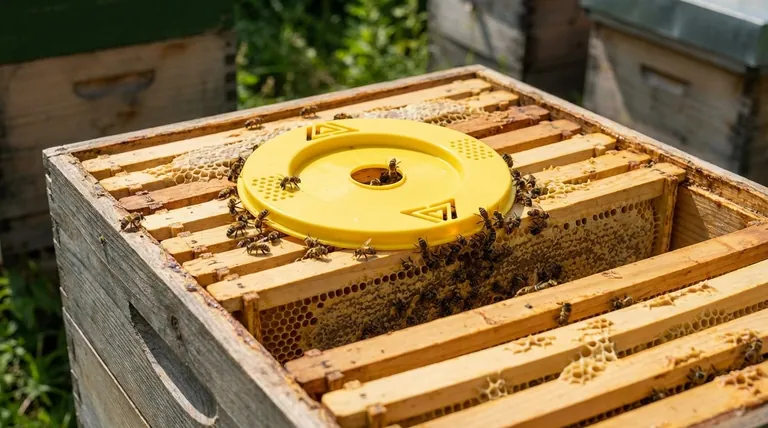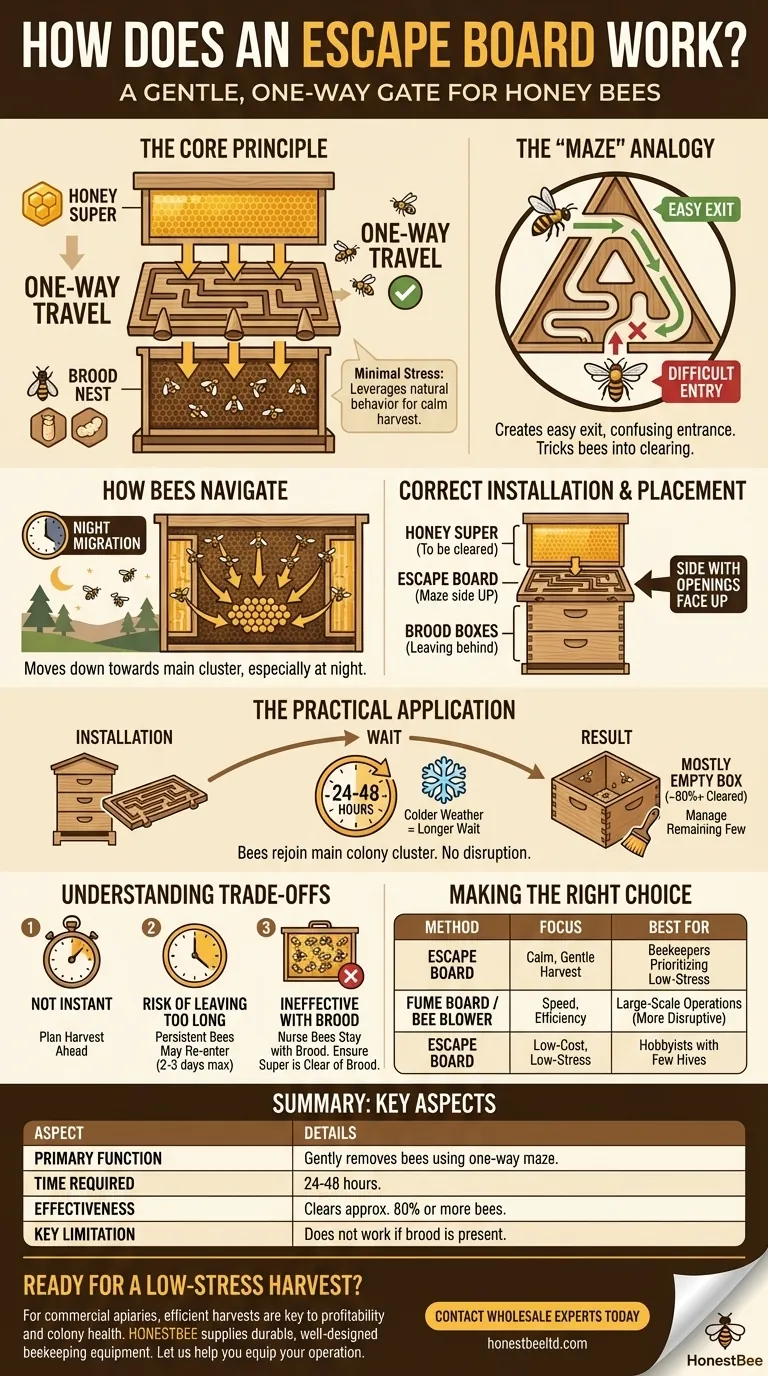At its core, an escape board is a one-way gate for honey bees. Also known as a clearer board, it is a simple device placed between hive boxes to gently remove bees from honey supers before a harvest. It allows bees to move downwards into the main hive but uses a simple maze-like design to prevent them from traveling back up.
The true purpose of an escape board is not just to clear bees, but to do so with minimal stress. It leverages the bees' natural behavior to make honey harvesting a calmer and more humane process for both the beekeeper and the colony.

The Core Principle: One-Way Travel
An escape board's design is brilliantly simple. It works by creating an easy exit route that is simultaneously a very confusing entrance route, effectively tricking the bees into clearing a hive box for you.
The "Maze" Analogy
Most modern escape boards, like the common triangle design, function as a small maze. The openings allow a bee to easily find its way down and out of the honey super. However, to get back in, the bee would have to navigate the maze in reverse, which is counterintuitive and difficult for them. This simple obstacle is enough to prevent their return.
How Bees Navigate Downward
The board takes advantage of the natural tendency for worker bees to move down from the outer honey supers and into the central brood nest, especially during the night. The board simply provides a path for this downward migration while blocking the return trip.
Correct Installation and Placement
To work effectively, the escape board must be placed correctly. It is inserted directly underneath the honey super (or supers) you intend to harvest and above the brood boxes or any supers you are leaving on the hive. The side with the escape openings must face up, into the super you want to clear.
The Practical Application: Clearing a Super for Harvest
Using an escape board requires a bit of planning, as it is not an instant solution. When used correctly, it is a highly effective and low-stress method for preparing your supers for extraction.
Timing is Everything
After installing the board, you must wait approximately 24 hours for the bees to clear out. In colder weather, bee movement is slower, so it may be necessary to wait up to 48 hours.
The Expected Result: A Mostly Empty Box
An escape board will not remove every single bee, but it is highly effective. You can expect it to clear roughly 80% or more of the bees from the super. The few remaining bees can be managed easily with a bee brush.
Where Do the Bees Go?
The bees are not lost or forced out of the hive. They simply move down into the lower boxes, rejoining the main colony cluster in the brood nest area. This is a natural movement that causes no disruption to the hive's social structure.
Understanding the Trade-offs and Pitfalls
While an excellent tool, the escape board is not the right choice for every situation. Understanding its limitations is key to using it successfully.
It Is Not an Instant Solution
Unlike a fume board or bee blower, which clears bees in minutes, an escape board requires a 24 to 48-hour waiting period. This means you must plan your harvest at least a day in advance.
The Risk of Leaving It Too Long
If you leave the board on for more than two or three days, some of the more persistent bees may eventually figure out how to navigate the maze in reverse. This will allow them to re-enter the super, defeating the purpose of the board.
Ineffectiveness with Brood in the Super
The board will fail if there is brood (eggs, larvae, or pupae) present in the honey super. Nurse bees will not abandon the brood, no matter what barriers are in place. Always ensure your honey supers are free of brood before installing an escape board.
Making the Right Choice for Your Harvest
Selecting a method to clear bees depends entirely on your goals, the size of your operation, and how much time you have.
- If your primary focus is a calm and gentle harvest: The escape board is the ideal tool, provided you can plan 24-48 hours ahead for it to work.
- If your primary focus is speed for a large-scale operation: A fume board or bee blower may be a more efficient choice, though these methods are significantly more disruptive and stressful for the colony.
- If you are a hobbyist with just a few hives: The escape board is an excellent, low-cost, and low-stress method that preserves the calm of your apiary.
Ultimately, using an escape board is about choosing a method that prioritizes the long-term health and well-being of your colony.
Summary Table:
| Key Aspect | Details |
|---|---|
| Primary Function | Gently removes bees from honey supers using a one-way maze design. |
| Best For | Beekeepers prioritizing a calm, low-stress harvest. |
| Time Required | 24-48 hours for bees to clear the super. |
| Effectiveness | Clears approximately 80% or more of the bees. |
| Key Limitation | Will not work if brood is present in the honey super. |
Ready to harvest honey with less stress for you and your bees?
For commercial apiaries and distributors, a smooth, efficient harvest is key to profitability and colony health. HONESTBEE supplies the durable, well-designed beekeeping equipment you need to succeed.
Let us help you equip your operation for success. Contact our wholesale experts today to discuss your needs for escape boards and other essential harvesting supplies.
Visual Guide

Related Products
- Circular Labyrinth Bee Escape for Efficient Hive Management
- High-Efficiency Diamond Maze Bee Escape for Clearing Supers
- Professional Durable Two-Piece Plastic Bee Escape
- Efficient Hive Clearing: HONESTBEE 8-Way Plastic Bee Escape
- HONESTBEE Multi Exit Plastic Bee Escape Board for Efficient Honey Harvesting
People Also Ask
- What happens if Triangular Escape Boards are left on for more than 24 hours? Risk of Bee Re-Entry and Failed Harvest
- What is the purpose of a bee escape board? A Gentle, Chemical-Free Way to Harvest Honey
- What is the function of an escape board in beekeeping? A Gentle Guide to Harvesting Honey
- What happens if an escape board is left on for too long? Avoid this common harvesting mistake
- What is a bee escape and why is it used in beekeeping? A Guide to Gentle Honey Harvesting



















